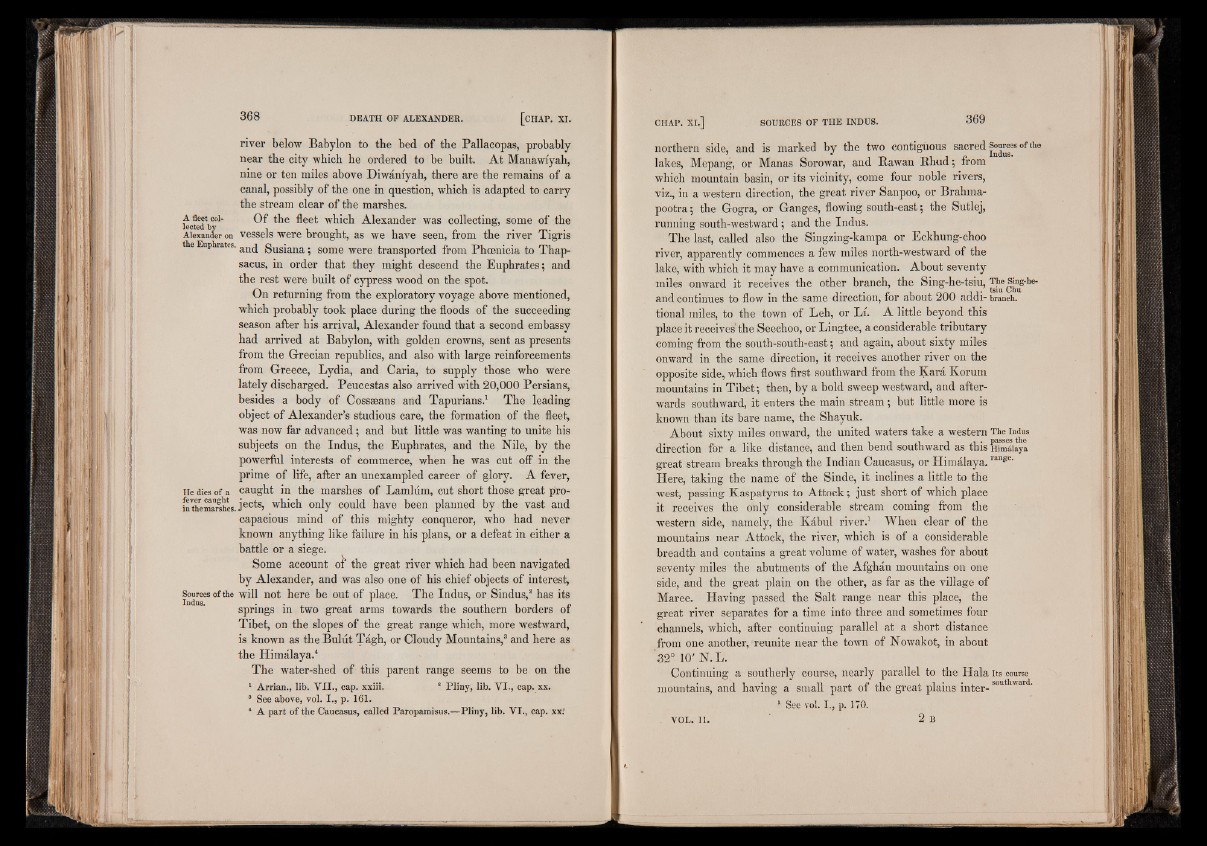
river below Babylon to the bed of the Pallacopas, probably
near the city which he ordered to be built. At Manawiyah,
nine or ten miles above Diwanfyah, there are the remains of a
canal, possibly of the one in question, which is adapted to carry
the stream clear of the marshes.
A fleet col- Of the fleet which Alexander lectedby - was collectin, g, so.me of the
Alexander on vessels were brought, as we have seen, from the river Tigris
e Euphrates. anq gusiana; some were transported from Phoenicia to Thap-
sacus, in order that they might descend the Euphrates; and
the rest were built of cypress wood on the spot.
On returning from the exploratory voyage above mentioned,
which probably took place during the floods of the succeeding
season after his arrival, Alexander found that a second embassy
had arrived at Babylon, with golden crowns, sent as presents
from the Grecian republics, and also with large reinforcements
from Greece, Lydia, and Caria, to supply those who were
lately discharged. Peucestas also arrived with 20,000 Persians,
besides a body of Cosseeans and Tapurians.1 The leading
object of Alexander’s studious care, the formation of the fleet,
was now far advanced; and but little was wanting to unite his
subjects on the Indus, the Euphrates, and the Nile, by the
powerful interests of commerce, when he was cut off in the
prime of life, after an unexampled career of glory. A fever,
He dies of a caught in the marshes of Lamlum, cut short those great pro-
fn^hemarshes. jects> which only could have been planned by the vast and
capacious mind of this mighty conqueror, who had never
known anything like failure in his plans, or a defeat in either a
battle or a siege.
Some account of the great river which had been navigated
by Alexander, and was also one of his chief objects of interest,
Sources of the will not here be out of place. The Indus, or Sindus,8 has its
springs in two great arms towards the southern borders of
Tibet, on the slopes of the great range which, more westward,
is known as the Bulut Tagh, or Cloudy Mountains,3 and here as
the Himalaya.4
The water-shed of this parent range seems to be on the
1 Arrian., lib. Y U ., cap. xxiii. ! Pliny, lib. V I., cap. xx.
3 See above, vol. I ., p. 161.
4 A part of the Caucasus, called Paropamisus.—Pliny, lib. VI., cap. xx.'
northern side, and is marked by the two contiguous sacred Sources of the
lakes, MepangW , or Manas Sorowar, andi Rawan tR-,1h ujd ; pfr om Indus.
which mountain basin, or its vicinity, come four noble rivers,
viz., in a western direction, the great river Sanpoo, or Brahmapootra
; the Gogra, or Ganges, flowing south-east; the Sutlej,
running south-westward; and the Indus.
The last, called also the Singzing-kampa or Eckhung-choo
river, apparently commences a few miles north-westward of the
lake, with which it may have a communication. About seventy
miles onward it receives the other branch,' the. Sing-he-ts1 i,u. , tTsmhe CSnmug-heand
continues to flow in the same direction, for about 200 addi- braneh.
tional miles, to the town of Leh, or Li. A little beyond this
place it receives the Seechoo, or Lingtee, a considerable tributary
coming from the south-south-east; and again, about sixty miles
onward in the same direction, it receives another river on the
opposite side, which flows first southward from the Kara Korum
mountains in Tibet; then, by a bold sweep westward, and afterwards
southward, it enters the main stream; but little more is
known than its bare name, the Shayuk.
About sixty miles onward, the united waters take a western The Indus
direction for a like distance, and then bend southward as this HbSaya
great stream breaks through the Indian Caucasus, or Himalaya.range-
Here, taking the name of the Sinde, it inclines a little to the
west, passing Kaspatyrus to Attock; just short of which place
it receives the only considerable stream coming from the
western side, namely, the Kabul river.1 When clear of the
mountains near Attock, the river, which is of a considerable
breadth and contains a great volume of water, washes for about
seventy miles the abutments of the Afghan mountains on one
side, and the great plain on the other, as far as the village of
Maree. Having passed the Salt range near this place, the
great river separates for a time into three and sometimes four
channels, which, after continuing parallel at a short distance
from one another, reunite near the town of .Nowakot, in about
32° 10' N.L.
Continuing a southerly course, nearly parallel to the Hala its course
mountains, and having a small part of the great plains inter-sou "
! See vol. I ., p. 3 VO.
. VOL. 11. 2 B